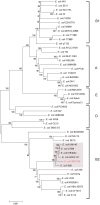Comparative genomic analysis shows that avian pathogenic Escherichia coli isolate IMT5155 (O2:K1:H5; ST complex 95, ST140) shares close relationship with ST95 APEC O1:K1 and human ExPEC O18:K1 strains
- PMID: 25397580
- PMCID: PMC4232414
- DOI: 10.1371/journal.pone.0112048
Comparative genomic analysis shows that avian pathogenic Escherichia coli isolate IMT5155 (O2:K1:H5; ST complex 95, ST140) shares close relationship with ST95 APEC O1:K1 and human ExPEC O18:K1 strains
Abstract
Avian pathogenic E. coli and human extraintestinal pathogenic E. coli serotypes O1, O2 and O18 strains isolated from different hosts are generally located in phylogroup B2 and ST complex 95, and they share similar genetic characteristics and pathogenicity, with no or minimal host specificity. They are popular objects for the study of ExPEC genetic characteristics and pathogenesis in recent years. Here, we investigated the evolution and genetic blueprint of APEC pathotype by performing phylogenetic and comparative genome analysis of avian pathogenic E. coli strain IMT5155 (O2:K1:H5; ST complex 95, ST140) with other E. coli pathotypes. Phylogeny analyses indicated that IMT5155 has closest evolutionary relationship with APEC O1, IHE3034, and UTI89. Comparative genomic analysis showed that IMT5155 and APEC O1 shared significant genetic overlap/similarities with human ExPEC dominant O18:K1 strains (IHE3034 and UTI89). Furthermore, the unique PAI I5155 (GI-12) was identified and found to be conserved in APEC O2 serotype isolates. GI-7 and GI-16 encoding two typical T6SSs in IMT5155 might be useful markers for the identification of ExPEC dominant serotypes (O1, O2, and O18) strains. IMT5155 contained a ColV plasmid p1ColV5155, which defined the APEC pathotype. The distribution analysis of 10 sequenced ExPEC pan-genome virulence factors among 47 sequenced E. coli strains provided meaningful information for B2 APEC/ExPEC-specific virulence factors, including several adhesins, invasins, toxins, iron acquisition systems, and so on. The pathogenicity tests of IMT5155 and other APEC O1:K1 and O2:K1 serotypes strains (isolated in China) through four animal models showed that they were highly virulent for avian colisepticemia and able to cause septicemia and meningitis in neonatal rats, suggesting zoonotic potential of these APEC O1:K1 and O2:K1 isolates.
Conflict of interest statement
Figures





References
-
- Kaper JB, Nataro JP, Mobley HL (2004) Pathogenic Escherichia coli . Nat Rev Microbiol 2: 123–140. - PubMed
-
- Croxen MA, Finlay BB (2010) Molecular mechanisms of Escherichia coli pathogenicity. Nat Rev Microbiol 8: 26–38. - PubMed
-
- Russo TA, Johnson JR (2000) Proposal for a new inclusive designation for extraintestinal pathogenic isolates of Escherichia coli: ExPEC. J Infect Dis 181: 1753–1754. - PubMed
Publication types
MeSH terms
Associated data
- Actions
- Actions
- Actions
LinkOut - more resources
Full Text Sources
Other Literature Sources
Molecular Biology Databases

